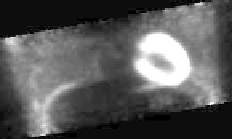Biomedical Engineering Reference
In-Depth Information
and
0
@
1
A
:
x
y
z
1
v =
Finding the unknown parameters is now the task, which can be solved
by iteratively applying a set of parameter values and calculating the distance
between the newly transformed floating image and the target image. The pa-
rameter values are then adjusted after each iteration as long as some stopping
criterion is not fulfilled. Many distance measures and stopping criteria are pos-
sible, some of which have been described in [7],[42],[43],[53],[69]. Using special
distance measures that are applicable to more than one modality simulta-
neously, registration between multi-modal images can also be achieved. An
example of rigid registration is shown in Figure 8.3.
In rigid registration the angles between the lines are preserved; i.e., a
square will remain a square after rigid registration. The method fails if the
deformed (floating) image has not preserved the angles between the lines. To
deal with such motion ane registration methods are required. These methods
use additionally 3 parameters for scaling and 3 for the skew. With this, a
square can be registered to a parallelogram.
8.2.3 Elastic motion correction
The rigid or ane registration methods provide a global transformation
function for the whole image. However, in medical imaging the motion of the
organs, especially in the thorax, does not follow a global pattern. The organs
describe different forms of motion and undergo deformations. For example,
the lungs expand in all directions during the inspiration, whereas the heart is
pressed downwards during the inhalation. The motion is not only in different
directions but also with varying magnitudes. Rigid or ane registration meth-
ods are thus not sucient and are inferior to non-rigid registration methods
in terms of accuracy [19]. The elastic registration methods describe the defor-
mation between the target and the floating image with the help of a vector
(a) Target image
(b) Floating image
FIGURE 8.3: Rigid motion. If the motion consists of only rotations and
translations, it is called rigid motion and is easy to correct.









Search WWH ::

Custom Search